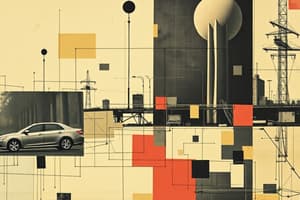Podcast
Questions and Answers
Match the following computer components with their primary functions:
Match the following computer components with their primary functions:
ALU = Executes arithmetic and logical operations Control Unit = Fetches and decodes instructions Registers = Temporarily stores data during processing Busses = Provides communication pathways between components
Match the following data types with their corresponding examples:
Match the following data types with their corresponding examples:
Integer = Whole number value, e.g., 5 String = Character sequence, e.g., 'hello' Boolean = True or false value Float = Decimal number value, e.g., 3.14
Match the following programming concepts with their definitions:
Match the following programming concepts with their definitions:
Abstraction = Focusing on essential features while ignoring non-essential details Decomposition = Breaking down complex problems into smaller, manageable parts Pattern recognition = Identifying and using recurring patterns in data Algorithm = Step-by-step procedure for solving a problem
Match the following types of secondary storage with their characteristics:
Match the following types of secondary storage with their characteristics:
Signup and view all the answers
Match the following flowchart shapes with their meanings:
Match the following flowchart shapes with their meanings:
Signup and view all the answers
Match the following Machine Learning concepts with their descriptions:
Match the following Machine Learning concepts with their descriptions:
Signup and view all the answers
Match the following electronic components with their purposes:
Match the following electronic components with their purposes:
Signup and view all the answers
Match the following stages of building a Machine Learning model with their descriptions:
Match the following stages of building a Machine Learning model with their descriptions:
Signup and view all the answers
Match the following types of AI with their descriptions:
Match the following types of AI with their descriptions:
Signup and view all the answers
Match the following parts of a Picoboard with their purposes:
Match the following parts of a Picoboard with their purposes:
Signup and view all the answers
Study Notes
Computers and Calculators
- Fixed computers: designed to perform a specific task, cannot be programmed
- Programmable computers: can be programmed to perform different tasks
- Calculators: designed for mathematical calculations, not programmable
- Computers: can perform various tasks, including calculations, and are programmable
Computer Components
- Inputs: devices that provide data to the computer (e.g., keyboard, mouse)
- Outputs: devices that display or produce output from the computer (e.g., monitor, printer)
- RAM (Random Access Memory): temporary storage for data and program instructions
- ROM (Read-Only Memory): permanent storage for programs and data
Secondary Storage
- Necessary for storing large amounts of data
- Types: Hard Disk Drives (HDD), Solid-State Drives (SSD), Flash Drives, Optical Drives (CD, DVD, Blu-ray)
CPU Components
- ALU (Arithmetic Logic Unit): performs mathematical operations
- Busses: pathways for data transfer between components
- Clock: controls the pace of operations
- Registers: small amount of memory for temporary storage
- Control Unit: manages and coordinates CPU operations
Operating System
- Manages Memory: allocates memory for programs
- Manages Program Execution: runs programs and allocates resources
- Manages Input and Output: coordinates communication between devices
- Manages User Interface (GUI): provides visual interface for user interaction
- Manages Communication: enables communication between devices and networks
Number Systems
- Denary (Base 10): human-readable number system
- Binary (Base 2): computer-readable number system
- Conversion: Denary to Binary and Binary to Denary
Data Storage
- Bit: smallest unit of memory
- Nibble: 4-bit unit of memory
- Byte: 8-bit unit of memory
- Kilobyte (KB): 1024 bytes
- Megabyte (MB): 1024 kilobytes
- Gigabyte (GB): 1024 megabytes
- Terabyte (TB): 1024 gigabytes
Algorithm and Flowchart
- Abstraction: breaking down complex problems into smaller parts
- Decomposition: dividing problems into smaller, manageable parts
- Pattern Recognition: identifying patterns in data
- Algorithm: step-by-step procedure for solving a problem
- Flowchart: visual representation of an algorithm
- Components of an Algorithm: inputs, processing, outputs
- Identifying parts of an algorthm: inputs, outputs, processing
- Order of steps in a program or algorithm
- Selection: making choices in a program or algorithm
- Repetition: using loops in a program or algorithm
- Variables: storing and changing values in a program or algorithm
- If-Else Statements: conditional statements in a program or algorithm
Programming Concepts
- Data Types: categorizing data for efficient storage and processing
- Casting Data Types: converting data types during input
- Loops: While Loops and For Loops
- Rules-Based Programming: program logic based on rules
- Data-Driven Programming: program logic based on data
Artificial Intelligence and Machine Learning
- Machine Learning: training models on data for decision-making
- Narrow AI: specialized AI for specific tasks
- General AI: human-like intelligence for broad tasks
- Supervised Learning: model training with labeled data
- Unsupervised Learning: model training with unlabeled data
- Reinforcement Learning: model training through rewards
- Semi-Supervised Learning: combination of supervised and unsupervised learning
- Defining the problem, Preparing Data, Training, Testing, Evaluating the Model
- Duplicates, missing data, invalid data
- Testing for Bias, measuring accuracy and confidence
- Bias in, Bias out
Electronics and Microcontrollers
- Picoboard: a microcontroller development board
- Components:
- GPIO pins: general-purpose input/output pins
- USB connector: connects to a computer
- CPU: central processing unit
- LED: light-emitting diode
- Debug pins: debugging interfaces
- GND pins: ground pins
- Power pins: power supply pins
- Electron Flow: direction of electron movement in a circuit
- Typical Voltage Levels: 3.3V, 5V, 9V, 12V
- Frequencies: Hz (e.g., 50Hz, 60Hz)
- Examples of microcontrollers: Arduino, Raspberry Pi
- Purposes of microcontrollers: automation, robotics, IoT, embedded systems
Studying That Suits You
Use AI to generate personalized quizzes and flashcards to suit your learning preferences.
Description
Assess your knowledge of computer systems, architecture, and components. This quiz covers differences between fixed and programmable computers, calculators vs computers, and the roles of RAM, ROM, and secondary storage. It also tests understanding of CPU components and the operating system's functions.




